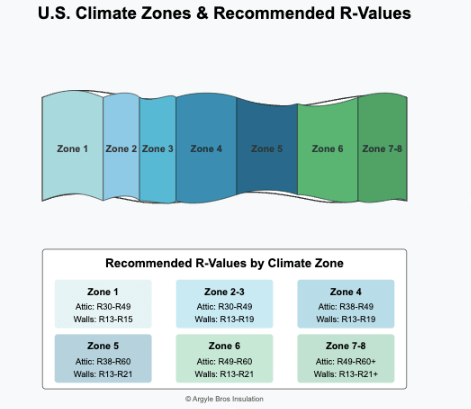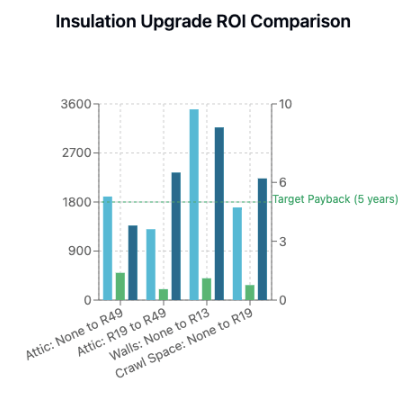Choosing R-value for Home Insulation
Is your wallet feeling a little lighter after paying those winter heating bills? Or maybe you're dreading the upcoming summer cooling costs? The secret to bringing those energy bills down might be hiding in plain sight – right in your walls, attic, and crawl spaces. It all comes down to choosing the right R-value for your home insulation.
But what exactly is R-value, and why should you care? Grab a warm beverage (or a cool one, depending on your current insulation situation!), and let's dive into the cozy world of insulation R-values together.
What R-Value Actually Means (In English, Not Science-Speak)
R-Value Effectiveness by Material Type
R-value measures thermal resistance – basically, how stubbornly your insulation fights against heat trying to sneak through it. Think of R-value like the bouncer at an exclusive club called "Comfortable Temperature." The higher the R-value, the tougher the bouncer, and the fewer uninvited heat molecules get to crash your party.
When we talk about insulation R-values, we're talking about a material's ability to resist heat flow. The higher the R-value, the better the insulation performance. But like that expensive gym membership, just having a high number doesn't automatically solve all your problems – you need to know how to use it right!
The "Coat" Theory of R-Value Selection
Let's make this super relatable. Choosing R-value is like picking the right coat for different weather conditions:
- R13-R15: Your light spring jacket. Good for mild climates or interior walls.
- R19-R21: Your standard winter coat. Solid for exterior walls in moderate climates.
- R30-R38: Your serious winter parka. Great for attics in warmer areas.
- R49-R60: Your "I'm climbing Everest" expedition gear. Perfect for attics in cold climates.
Just like you wouldn't wear a t-shirt in a snowstorm or a parka at the beach, matching your insulation R-value to your specific needs is the key to comfort and energy savings.
Determining How Much Insulation Your Home Actually Needs
How much insulation you need depends on several factors:
- Where you live (climate zone)
- Which part of your house we're talking about
- Your energy efficiency goals
- Local building codes (the rules you gotta follow)
Let's break down the recommended R-values by area:
Attic Insulation: The Winter Hat of Your Home
Your attic is like the hat on your head – where a significant amount of heat escapes if not properly protected. For attic insulation, the recommendations vary by climate:
- Warm climates (Zones 1-3): R30 to R49
- Moderate climates (Zones 4-5): R38 to R60
- Cold climates (Zones 6-8): R49 to R60+
Many homeowners ask: "Is R19 or R30 better for an attic?" Here's the truth: in most of the country, R19 is like bringing a knife to a gunfight – technically a weapon, but not nearly enough for the job. For attic spaces, higher R-value is almost always worth the investment.
Remember: heat rises, making your attic floor a prime escape route for all that cozy warmth you're paying good money to generate!
Wall Insulation: Your Home's Thermal Sweater
For exterior walls, the story gets a bit more complicated because you're working with limited space inside wall cavities:
- 2x4 walls: Usually fit R13 to R15 insulation
- 2x6 walls: Can accommodate R19 to R21
A common question is: "Is R13 or R19 better for walls?" The simple answer is R19, but the real question is: does it fit in your wall? If you have standard 2x4 walls, R13 or R15 is your realistic target unless you're doing major renovations or using specialized products like spray foam insulation.
Wall insulation prevents heat transfer through your largest surface areas. Proper wall insulation can dramatically reduce heating and cooling costs while keeping indoor temperatures stable year-round.
Crawl Spaces and Basements: The Forgotten Thermal Leaks
Crawl spaces are often the forgotten stepchildren of home insulation, but they deserve your love too! For these areas:
- Floor insulation above unheated crawl spaces: R25 to R30
- Crawl space walls (if enclosed): R10 to R19
Insulation in crawl spaces not only improves energy efficiency but also helps prevent moisture problems that can lead to mold and structural issues. Double win!
The Thermal Bridging Problem Nobody Talks About
Here's something many insulation guides won't tell you: the actual R-value of your wall is often lower than the insulation's rated R-value due to something called thermal bridging. This happens when heat bypasses your insulation by traveling through your wall studs.
Think of it like having a bucket with tiny holes – doesn't matter how high you fill it, water still leaks out. In a typical 2x4 wall with R13 fiberglass batts installed perfectly between studs, the overall R-value of the wall might only be R11 because of thermal bridging through the wood studs.
Solutions include:
- Adding a continuous layer of rigid foam boards over studs
- Using spray foam insulation in key areas
- Installing insulated sheathing
Higher R-Value: When More Is Better (And When It's Just More Expensive)
*Note: Percentages represent approximate energy savings compared to the previous R-value level. Cost-benefit ratio varies by climate zone and energy costs.
Diminishing Returns of R-Value Increases
The relationship between R-value and energy savings isn't perfectly linear. Jumping from R5 to R10 saves more energy than going from R30 to R35, despite both being a "+5" increase.
It's like adding blankets to your bed on a cold night. The first blanket makes a huge difference, the second helps a lot too, but by the fifth blanket, you're barely feeling additional benefit (and might be a bit squished!).
For most homes, there's a sweet spot where you get maximum benefit for your insulation dollar:
- Attic: R49-R60 in most climates
- Walls: The highest value that physically fits (typically R13-R21)
- Floors over unconditioned space: R25-R30
Spray Foam Insulation: The R-Value Champion
When it comes to insulating power per inch, spray foam insulation stands alone. With R-values ranging from R5.5 to R6.5 per inch for closed-cell spray foam (nearly double traditional fiberglass batts), it's particularly valuable for tight spaces where every inch counts.
The benefits of spray foam go beyond just R-value:
- Creates an air seal (reducing heat loss from air leaks)
- Works as a vapor barrier (preventing moisture issues)
- Doesn't settle or compress over time
- Fills irregular spaces perfectly
While the upfront cost is higher, the long-term energy savings and improved home comfort often make spray foam worth considering, especially for problem areas.
The Climate Zone R-Value Map: Your Insulation Shopping Guide
Different parts of the country have different insulation needs. Here's a quick breakdown:
- Zones 1-2 (Hot climates like Florida, Texas): Focus on attic insulation (R30-R49) to keep heat OUT
- Zones 3-4 (Mixed climates like Tennessee, Virginia): Balanced approach needed (R38-R49 in attic, R13-R19 in walls)
- Zones 5-8 (Colder regions like New York, Minnesota): Maximum insulation recommended (R49-R60 in attic, R19-R21 in walls where possible)
Remember that local building codes establish minimum R-values, but these are just that – minimums. For optimal energy efficiency, you'll often want to exceed these requirements.
DIY vs Professional Installation: Getting the R-Value You Paid For
A quick reality check: an R30 insulation product installed poorly might perform like R20 (or worse). Proper installation is absolutely critical to achieving the thermal performance you're paying for.
While DIY insulation projects can be cost-effective for simple applications like laying additional batts in an open attic, more complex applications often benefit from professional installation:
- Spray foam insulation should always be professionally installed
- Addressing air leaks requires expertise and special equipment
- Wall insulation in existing homes needs specialized techniques
We've seen plenty of DIY insulation disasters over the years - from attics that became accidental saunas due to blocked vents, to walls with more gaps than a hockey player's smile. Getting professional installation means you won't be starring in our mental "insulation fail" hall of fame!
Energy Savings by R-Value Upgrades
Average ROI for Insulation Upgrades
*Figures are estimates based on a 2,000 sq ft home. Actual savings vary by climate, energy costs, and existing home efficiency.
Final Thoughts: Investing in Your Home's Energy Future
Choosing the right R-value is about finding the sweet spot between upfront cost and long-term energy savings. While higher R-value generally means better insulation, the correct R-value for your specific situation depends on your climate, your home's construction, and your energy efficiency goals.
Ready to get serious about your home's insulation? Contact us for a no-obligation consultation. Our team can help determine exactly what R-values your home needs in each area, recommend the best insulation types for your situation, and provide professional installation that ensures you get the full performance you're paying for.
Remember, a well-insulated home isn't just about saving money – it's about creating a comfortable, healthy living environment for you and your family. And that's something you simply can't put a price tag





